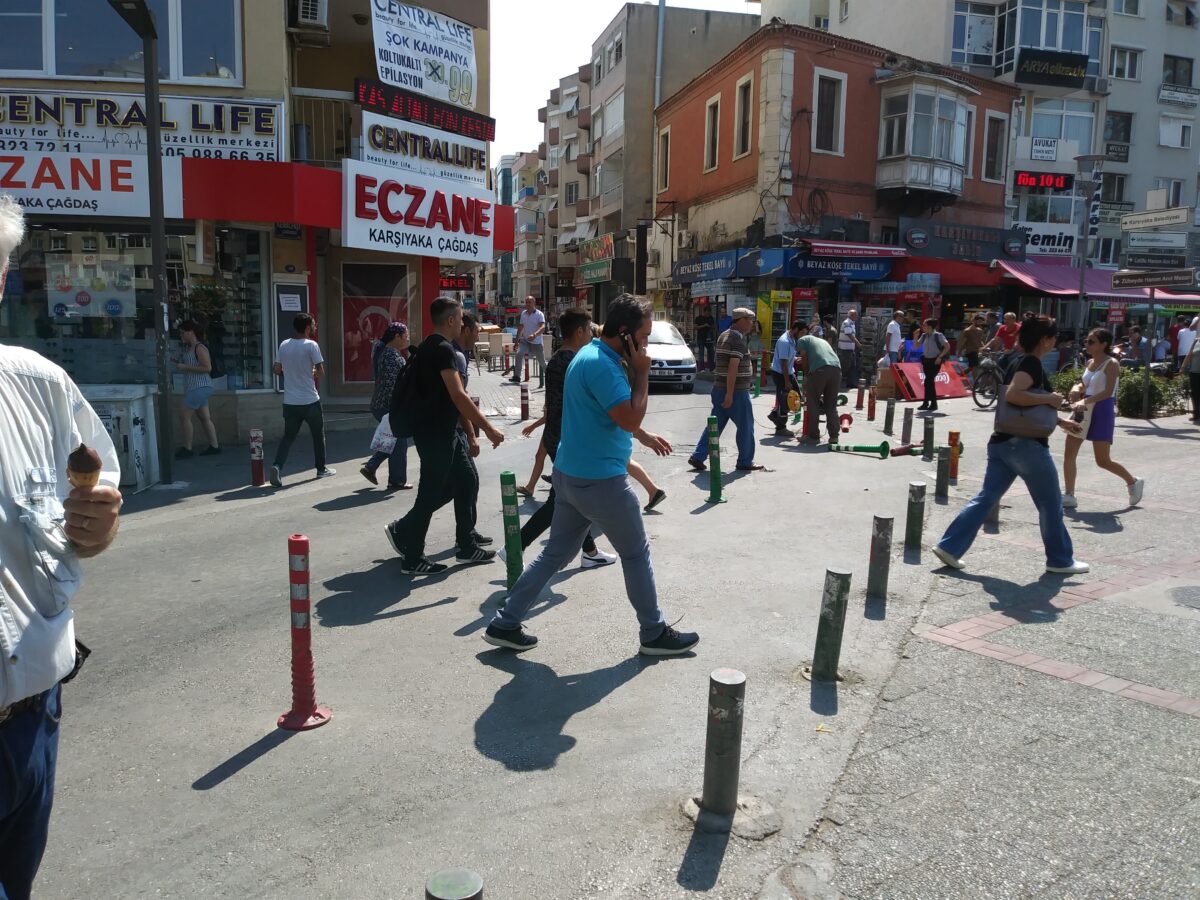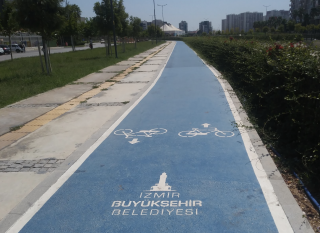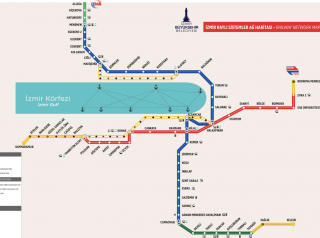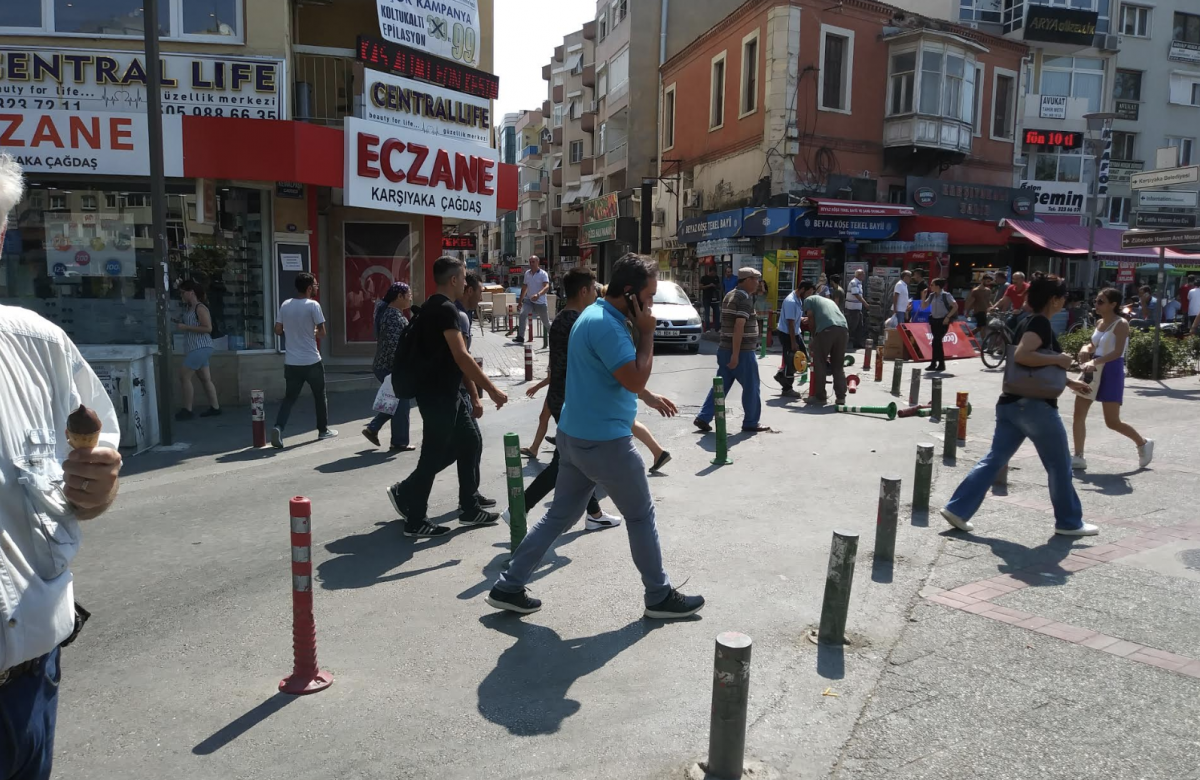
(Photos: Timur Ender)
BikePortland subscriber Timur Ender recently visited family in Turkey and shares his impressions about how people get around.
My first memories of Izmir were when I was a young kid so it has been a joy to see it grow in a positive direction over the last 25 years.
Izmir is the third largest city in Turkey and has a population of 3 million people. It is a major port and hub for commerce and a center for higher education, agriculture, and manufacturing. Given its location and weather, Izmir is known for its quality of life and tourism, attracting direct flights from northern Europe to its sunny beaches.
For me, Izmir has a much more personal connection. It’s where my family lives and where I have spent a significant amount of time over the years. It’s a place I’ve watched with admiration as the city has grown and changed over the last two decades. Given how impressive I found the multimodal improvements during my most recent visit this summer, I thought I’d share some pictures about what Izmir is doing to improve transportation options and quality of life in a quickly growing region.
Izmir is a city clustered around a bay with development occurring up toward the hills and along the bay in every direction. Not surprisingly, most transportation investments have been clustered around the bay. The thought being that if you can get near the water (with bus service), you can access regional transportation options like streetcar, light rail, protected bike lanes, ferries, busses, and bike share.
Below are descriptions of recent improvements by transportation mode in no particular order.
Ferries as a transportation demand management (TDM) strategy
Ferries offer a shortcut from one part of the bay to the other. Some transport cars while others are bike/ped only. The frequency and speed of these ferries makes them competitive to driving. It seems the Izmir government has embraced the potential of ferries as a TDM strategy and is prioritizing the procurement of even more bike/ped only boats, providing greater frequency, and adding service hours between 12 a.m. – 3 a.m.
Biking and the benefits of being the first Turkish city to have a bike master plan
There has been a strong advocacy push over the past two decades to connect the bay by bike. With the election of political leaders supportive of this goal as well as funding to make it happen, it appears this has finally become a reality. The bikes lanes are blue and bi-directional. The standard width is six feet (yes, for bi-directional lanes). Another interesting fact is that the jurisdiction providing the funding is prominently displayed on the bike paths, in this case the provincial government. Izmir also has a bike share system with strategic station siting. It is called “our bikeshare” and its slogan is, “now the streets belong to us”.
Izmir’s success in bicycling is due in part to a comprehensive plan, not just for biking but for active transportation generally. This can be seen in how bus fare payment is integrated across multiple transportation modes and municipal parking and cultural facilities. And it can also be seen in how well biking is integrated with other modes, which is probably the greatest win for people riding bikes. The highest quality bike infrastructure exists around ferry stations, new busses feature bike racks, and the bay is connected by bike. All of these discrete but intentionally planned efforts have made it easier for residents to combine modes and conveniently bike from one part of the region to the other. In a part of the world that lacks a reputation for planning, Izmir has shown the possibilities of a connected and integrated active transportation system.
“Dolmus” = Private operators supplementing public transit.
Dolmus is a turkish word meaning “full”. Although there is a rough timetable, these busses generally leave the station when they are full, hence the name. It’s a system of a fixed route, frequent service, green-colored buses connecting people to high capacity transit. Dolmus are operated by private actors in the public transportation arena and are regulated by the government. They require permit approval from the municipality and police traffic division to ensure there is sufficient demand for the route proposed by the private operator and that the route proposed is safe.
Regional rail reducing crosstown commute times.
Izmir has an impressive rail system. It connects outlying areas with the region’s commercial centers. Moreover, most towns and the airport are all on the same rail line. We took a long-distance train from Izmir to Eskisehir and eventually Istanbul. Interestingly there weren’t any at-grade rail crossings until we left the Izmir region which seemed pretty impressive for a densely populated area. Also of note was that long distance rail uses the same exact tracks as regional light rail until it leaves the metro area (with regional rail having priority over long distance). The regional rail system is heavily used and connects people from all parts of the region. Similar to the ferry, given the congestion for cars, taking rail is competitive to driving in the urban core.
Advertisement
A new streetcar line invites more people to walk
The modern Streetcar is about four years old in Izmir; the first modern streetcar systems in Turkey were launched about 20 years ago. The route is located along bustling streets, dense housing, and for portions, along the bay. The stops feature accessible at grade crossings and modern designs. The streetcar runs on dedicated tracks supplemented with bollards to keep cars out which ensures it never gets stuck in car traffic. The streetcars themselves are clean, visually appealing, and spacious. The service is not all that frequent for what one would expect in a high-density area (it comes about every 12 min or so). The low frequency does have the side effect of promoting walking. Anecdotally, my aunt described how she would get to the station, see that the train is 7 min away and decide to walk instead. And while the frequency currently is relatively low, the trains are highly utilized given the proximity to dense housing.
Giant steps toward a walkable city


There were many examples of walking-friendly street design. In Yeni Foca (at right), a beach 45 minutes outside downtown (but still within Izmir province), has changed its main street from two general traffic lanes to a carfree promenade. When I was young, my brothers and I spent our summers here. At night the street would be closed to cars to accommodate the intense amount of people strolling along the waterfront. After dinner, entire families would go on a walk to get ice cream, take in the cool ocean breeze and see neighbors. Today, the permanent waterfront street design features an accessible sidewalk, a blue protected bike lane, and one lane for freight access (garbage service and emergency vehicles only). Our family friends living nearby let their kids roam freely between the beach and their house, seemingly unwilling to find any distinction between a park and the street in front of their house.
Back in downtown Izmir, pedestrian streets begin where the ferry and streetcar lines end. My mom has dubbed this part of Karsayka, the “culinary corridor” due to its flavorful selection of delicious food. Moreover, the main walking corridor had carfree streets intersecting it which made for an attractive pedestrian district full of vibrant storefronts. The opposite end of the culinary corridor is anchored by regional light rail and dolmus shuttles ready to take you in any direction.
Another walking friendly street design I came across was the raised crosswalk. This was a speed bump, accessible crosswalk, and pedestrian safety treatment all in one. The raised asphalt makes people walking more visible and negates the need for an expensive curb ramp. This allows people crossing the street to remain at sidewalk level.
Slow cities as the original Vision Zero?
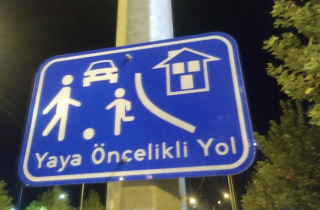
Seferihisar is one of the many beautiful small towns in the Izmir province. It encompasses architectural sites, side-of-the-road farm stands, and colorful storefronts. Seferihisar was the first city in Turkey to be named a “slow city”, a fact locals were happy to mention but something I was not familiar with. The Cittaslow movement began in Italy and originated from the slow food movement. In Seferihisar, they have used it as an opportunity to promote slow driving and traffic safety as part of their slow city initiative.
The sweet taste of Izmir’s mode share pie
What do all these plans, investments, and policies add up to? For starters, Izmir residents enjoy a wide range of mobility options. These benefits exhibit themselves in better air quality, healthier population, and improved mental health as people enjoy convenient access to human connections, cultural institutions, town centers.
So how does Izmir’s mode share actually shake out? According to the provincial government, it looks like this:
— 24% by private car
— 11% by shuttle (this generally means a bus operated by a private entity to bring people to places like grade schools, colleges, companies, and shopping centers).
— 28% public transportation (this includes dolmus, ferries, rail, and bus).
— 37% carfree (this includes walking and biking; though the vast majority is walking).
Overall, I was impressed with the effort, objectives, and outcomes related to multimodal mobility in Izmir. My first memories of Izmir were when I was a young kid so it has been a joy to see it grow in a positive direction over the last 25 years. The groundwork laid years ago and being implemented today is already improving the quality of life and access to opportunity for Izmir residents and is setting up the region to become a national and international example of best practices for mobility and urban planning.
Timur Ender is an advocate for equitable and livable cities and is on the board of the nonprofit Oregon Walks.
